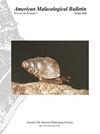Sexual Differentiation and size at First Maturity of the Mussel Choromytilus chorus (Molina, 1782) (Mollusca, Bivalvia) in Northern Chile.
IF 0.4
4区 生物学
Q4 MARINE & FRESHWATER BIOLOGY
引用次数: 5
Abstract
Abstract: The mussel Choromytilus chorus (Molina, 1782) is a commercially and ecologically important bivalve, which is extensively distributed along the Chilean coast (20°S–54°S). However, there are no previous studies regarding the reproductive aspects of this species in the northern part of its range. Mussels were collected at Caleta Errázuriz, along the Antofagasta coast (ca. 24°S), between December 2014 and June 2015. A total of 1620 individuals were examined using histological techniques and macroscopic visual inspection. Seventeen size categories, which included individuals from 5 mm to 100 mm in length, were analyzed. The size at the onset of sexual differentiation and the size at first sexual maturity (50% mature individuals) were determined. Males comprised 49% of the total sample, and 51% were females. Mussels from 5–22 mm in valve length were undifferentiated and from 22–24 mm were sexually differentiated. The size at first sexual maturity was recorded as 38–40 mm. In vitro fertilization trials demonstrated that sexually differentiated individuals were able to produce viable gametes. The biological parameters analyzed for C. chorus were similar to those recorded for populations of this bivalve from the southern latitudes. However, the lower number of eggs per female and the smaller egg size suggests that the population parameters may be different for C. chorus between the northern and southern latitudes.智利北部贻贝Choromytilus chorus (Molina, 1782)(软体动物,Bivalvia)首次成熟时的性别分化和大小。
摘要:贻贝Choromytilus chorus (Molina, 1782)是一种具有重要商业价值和生态价值的双壳类动物,广泛分布于智利沿海(20°S - 54°S)。然而,在其分布范围的北部地区,尚无关于该物种生殖方面的研究。贻贝于2014年12月至2015年6月在Antofagasta海岸(约24°S)的卡莱塔Errázuriz收集。采用组织学技术和肉眼检查共对1620例个体进行了检查。分析了17个尺寸类别,包括个体从5毫米到100毫米的长度。测定了性分化开始时的大小和初次性成熟时(50%成熟个体)的大小。男性占总样本的49%,女性占51%。阀长在5 ~ 22mm的贻贝未分化,阀长在22 ~ 24mm的贻贝有性分化。初性成熟时大小为38 ~ 40 mm。体外受精试验表明,性别分化的个体能够产生可存活的配子。分析的生物参数与南纬双壳类种群的生物学参数相似。然而,每只雌鸟的卵数较低,卵的大小较小,这表明南北纬地区的种群参数可能不同。
本文章由计算机程序翻译,如有差异,请以英文原文为准。
求助全文
约1分钟内获得全文
求助全文
来源期刊
CiteScore
1.00
自引率
40.00%
发文量
1
审稿时长
>12 weeks
期刊介绍:
The American Malacological Bulletin serves as an outlet for reporting notable contributions in malacological research. Manuscripts concerning any aspect of original, unpublished research,important short reports, and detailed reviews dealing with molluscs will be considered for publication. Recent issues have included AMS symposia, independent papers, research notes,and book reviews. All published research articles in this journal have undergone rigorous peer review, based on initial editor screening and anonymous reviewing by independent expertreferees. AMS symposium papers have undergone peer review by symposium organizer, symposium participants, and independent referees.

 求助内容:
求助内容: 应助结果提醒方式:
应助结果提醒方式:


